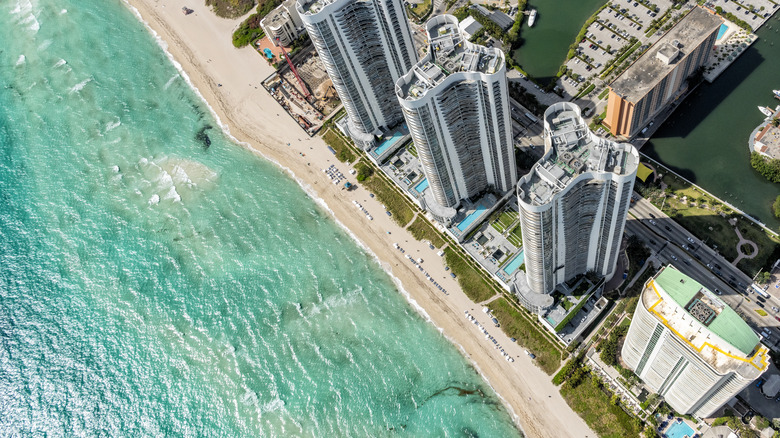You May Want To Think Twice Before Visiting This Popular Florida Beach Destination
Florida beach lovers are no strangers to dangerous beaches. There are a handful that you should just skip while visiting the state, for all kinds of reasons. These oceanfront havens can quickly become a harrowing experience for unsuspecting visitors, which is why you may want to reconsider spending the day at any of the beaches in the North Beach area of Miami. Savoteur even named North Beach the deadliest beach in the country. The rip currents and dangerous sea life alone are enough to put even the most frequent beachgoer off-kilter.
Miami is a popular beachfront vacation destination with its many sandy beaches outlining the landscape. Unlike the city's South Beach, North Beach is a snoozier kind of beach neighborhood. You won't butt up against as many tourists or fight over the best umbrella spot, which may make it seem less concerning. Just because the beach isn't bustling doesn't mean you should let your guard all the way down.
To be safe, you should always check an area's safety warnings before jumping in. Although not super common, North Beach beaches are double red flagged from time to time by the local health department, meaning the area is closed to swimming. Fourth of July beachgoers in 2024 were disappointed because swimming was closed due to high levels of enterococcus bacteria caused by fecal matter. For vacationers, it's important to know that Miami officials sample swimming water for bacteria on Monday mornings, and results are in the following day.
High occurrence of rip currents
While not among the most dangerous spots to swim in the world, the North Beach area, and South Florida in general, is known for rip currents. Rip currents are also a problem at another dangerous beach in Florida as well, New Smyrna Beach in Volusia County. Unlike a rip tide, which goes out with the tide, a rip current moves at an angle away from the shoreline. Because of this odd movement, even a strong swimmer can quickly be overtaken by the current. If you are caught in one, try swimming parallel to the shore since currents are not very wide. They can become more intense if waves are high and fast, since they're caused by wave breaks along the beach.
Rip currents are a significant issue in South Florida, so much so that the National Weather Service called them the "deadliest weather-related hazard" in the area. "Since 1979, rip currents, sometimes erroneously referred to as rip tides or undertows, have claimed more lives in South Florida than any other weather-related hazard combined, including hurricanes, tornadoes, and lightning!" per the organization.
The NWS added that rip currents are issues for nearly all surf beaches on the southern coast of Florida. Rip currents are not to be taken lightly. If you see notices indicating high rip currents, pay attention. In 2023, 82 people were killed in rip currents nationwide but 31 of those incidents were in Florida.
Jellyfish and sharks abound
When you're dealing with Florida waters, you're also dealing with Florida sharks. Although the risk of dying from a shark attack is one in 4.3 million, it doesn't stop visitors from making a pause to take in Florida beaches. After all, sharks like the water there for a lot of the same reasons people do — it's warm, shallow, and plentiful. Be aware that they are around and take comfort in knowing that you're far more likely to get struck by lightning than to get bitten by a shark.
Florida may be home to an area known as the Shark Bite Capital of the World, but sharks aren't the only sea life you need to be aware of. North Beach, and Miami in general, is home to a bunch of jellyfish. These stinging blobbies are always around, though they appear in far greater numbers from May to October. Generally, the two jellies you'll see in the Miami area are moon and cannonball jellyfish.
Besides those, you'll also encounter Portuguese Man o' War. More bloated sea snail than jellyfish, these suckers also pack a mean sting if you touch them. Be especially careful walking around the beach since these fellas are easily thrown onto the shore because they float instead of swim. To make matters worse, according to the National Ocean Service, a Man o' War can sting even if its been washed up for weeks. It's best to give them a wide berth.
